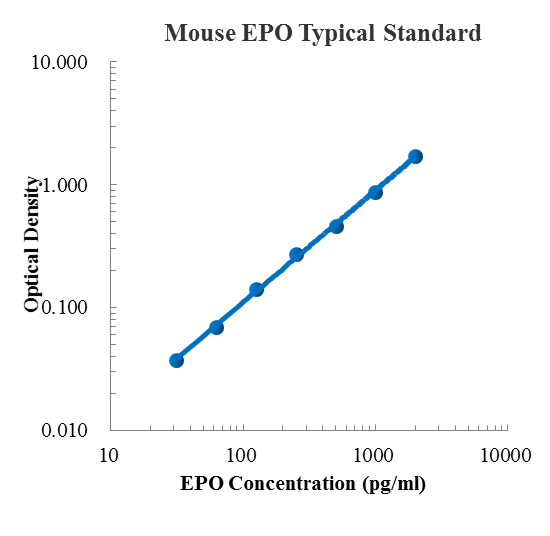
Mouse Erythropoietin/EPO ELISA Kit
$350.00 – $450.00
| Sample Type | Serum, plasma, cell culture supernatant, and other biological samples |
|---|---|
| Sample Volume | 10 μL |
| Sensitivity | 2.91 pg/mL |
| Range | 31.25 pg/mL – 2000 pg/mL |
| Assay Time | 3.5 h |
| Recovery | 83% – 125% |
| Average Recovery | 1.08 |
| Intra Precision | 2.3% – 4.1% |
| Inter-Precision | 3.9%-5.1% |
| Platform | ELISA |
| Plate | Detachable 96-well plate |
| Size | 96T/48T |
| Storage | If the reagent kit is unopened, it should be stored at 4℃. However, if it has been opened, the standard solution should be stored at -20℃, while the other components should be stored at 4℃. |
| Delivery | 4℃ blue ice transportation |
| Components | 96-well polystyrene enzyme-linked immunosorbent assay (ELISA) plate coated with anti-EPO monoclonal antibody Mouse EPO freeze-dried standard Mouse EPO detect Antibody Standard Diluent Assay Buffer(10×) Substrate TMB Stop Solution Washing Buffer(20×) Sealing Film |
| Assay Principle | This kit utilizes the double antibody sandwich enzyme-linked immunosorbent assay (ELISA) detection technique.Specific anti-mouse EPO antibodies are precoated on a high-affinity ELISA plate.Standards and test samples are added to the wells of the ELISA plate. After incubation, the EPO present in the samples binds to the solid-phase antibodies. After washing to remove unbound substances, biotinylated detection antibodies are added and incubated. After washing to remove unbound biotinylated antibodies, streptavidin-HRP labeled with horseradish peroxidase is added. After washing, a colorimetric substrate, TMB, is added and the plate is incubated in the dark for color development. The intensity of the color reaction is directly proportional to the concentration of EPO in the samples.A stop solution is added to terminate the reaction, and the absorbance value is measured at a wavelength of 450 nm (with a reference wavelength range of 570-630 nm). |
Targets
EPO
EPO Target Infomation Overview
- Target Symbol: EPO, erythropoietin
- Gene Groups: Receptor ligands
- Alias: EP
EPO, erythropoietin Target Infomation by Species
[su_tabs][su_tab title=”Human” disabled=”no” anchor=”” url=”” target=”blank” class=”tab-human”]
Human EPO Target Information
- Target Symbol: EPO, erythropoietin
- Alias:
- DBAL
- ECYT5
- EP
- epoetin
- MGC138142
- MVCD2
- NCBI_Gene: 2056
- UniProtKB: P01588
Human EPO Predicted Functions
Enables cytokine activity and erythropoietin receptor binding activity. Involved in several processes, including negative regulation of apoptotic process; negative regulation of ion transport; and regulation of transcription, DNA-templated. Located in cell surface and extracellular space. Implicated in several diseases, including artery disease (multiple); diabetic angiopathy; familial erythrocytosis 5; ischemia (multiple); and neurodegenerative disease (multiple). Biomarker of amyotrophic lateral sclerosis; anemia; breast cancer; eye disease (multiple); and glucose metabolism disease (multiple).
[/su_tab]
[su_tab title=”Mouse” disabled=”no” anchor=”” url=”” target=”blank” class=”tab-mouse”]
Mouse Epo Target Information
- Target Symbol: Epo, erythropoietin
- Alias:
- 无
- NCBI_Gene: 13856
Mouse Epo Predicted Functions
Enables protein kinase activator activity. Involved in negative regulation of apoptotic process; peptidyl-serine phosphorylation; and positive regulation of protein kinase activity. Acts upstream of or within several processes, including embryo implantation; erythrocyte differentiation; and hemoglobin biosynthetic process. Located in extracellular space. Is expressed in several structures, including egg cylinder; embryo mesenchyme; embryo mesoderm; nervous system; and placenta. Human ortholog(s) of this gene implicated in several diseases, including artery disease (multiple); diabetic angiopathy; familial erythrocytosis 5; ischemia (multiple); and neurodegenerative disease (multiple). Orthologous to human EPO (erythropoietin).
[/su_tab]
[su_tab title=”Rat” disabled=”no” anchor=”” url=”” target=”blank” class=”tab-rat”]
Rat Epo Target Information
- Target Symbol: Epo, erythropoietin
- Alias:
- 无
- NCBI_Gene: 24335
- UniProtKB: P29676
Rat Epo Predicted Functions
Predicted to enable cytokine activity; erythropoietin receptor binding activity; and protein kinase activator activity. Involved in several processes, including positive regulation of ERK1 and ERK2 cascade; positive regulation of activated T cell proliferation; and response to dexamethasone. Located in cell body and extracellular space. Used to study retinal detachment and visual epilepsy. Biomarker of cholangiocarcinoma; eye disease (multiple); transient cerebral ischemia; and vascular dementia. Human ortholog(s) of this gene implicated in several diseases, including artery disease (multiple); diabetic angiopathy; familial erythrocytosis 5; ischemia (multiple); and neurodegenerative disease (multiple). Orthologous to human EPO (erythropoietin).
[/su_tab][/su_tabs]
EPO Target News
[catlist tags=”epo” template=targetnews thumbnail=yes thumbnail_class=”related-post-media clr” thumbnail_size=833]





